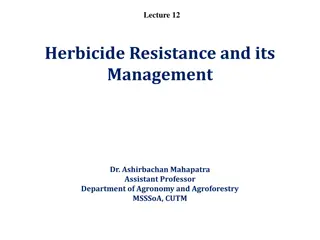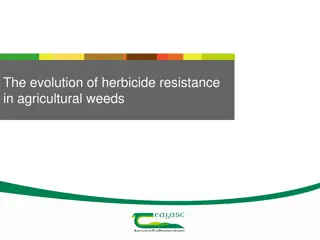Understanding Adjuvants and Herbicide Formulation
Adjuvants are additives that enhance herbicide effectiveness, crucial for optimal weed control. Types include surfactants, stabilizing agents, coupling agents, humectants, deposit builders, and more. Surfactants aid in wetting and spreading herbicides, stabilizing agents keep suspensions intact, coupling agents enhance solubility, and humectants prevent rapid drying. Choosing the right adjuvant can make a significant difference in herbicide performance.
Download Presentation

Please find below an Image/Link to download the presentation.
The content on the website is provided AS IS for your information and personal use only. It may not be sold, licensed, or shared on other websites without obtaining consent from the author. Download presentation by click this link. If you encounter any issues during the download, it is possible that the publisher has removed the file from their server.
E N D
Presentation Transcript
Lecture 8 Concept of Adjuvant, Surfactant, Herbicide Formulation and their Use Dr. Ashirbachan Mahapatra Assistant Professor Department of Agronomy and Agroforestry MSSSoA, CUTM
Adjuvant An adjuvant is an additive that is intended to improve the effectiveness of a herbicide. Some herbicides require no additional adjuvants to perform well, but some perform better with adjuvants, and this is usually detailed on the product label. Adjuvants are chemicals employed to improve the herbicidal effects, sometimes making a difference between satisfactory and unsatisfactory weed control. Adjuvants aid the herbicide availability at the action site in plants. Some important kinds of adjuvants are: 1. Surfactant (Surface active agents) 2. Stabilizing agents 3. Coupling agents (Solvents and co-solvents) 4. Humicants (Hygroscopic agents) 5. Deposit builders (Stickers or filming agents) 6. Compatibility agents 7. Activators (Synergists) 8. Drift control agents
1. Surfactant (Surface active agents) a) Aid in wetting the waxy leaf surface with aqueous herbicide sprays (wetting agents) b) In spreading the hydrophilic herbicides uniformly over the foliage (spreaders) c) In the penetration of herbicide into the target leaves and stems (penetrates) you dip a leaf of Cynodon dactylon and pull it back, you can see the leaf without wetting. But if you add a drop of surfactant you can readily wet the foliage.). With the addition of surfactant, the water drop flattens down to wet the leaf surface and let the herbicide act properly. A water drop is held as a ball on a waxy leaf surface. (Take water in a beaker, if
2. Stabilizing agents a) Emulsifiers: A substance which stabilizes (reduces the tendency to separate) a suspension of droplets of one liquid which otherwise would not mix with the first one. It substitutes for constant agitation of spray liquids during field operation. Eg., ABS, Solvaid, 15-5-3, 15-5-9. b) Dispersing suspensions. They keep fine parricides of wettable powder in suspension in water even after initial vigorous agitation has been withdrawn. They act by increasing the hydration of fine particles of WP laden with the herbicides. agents: They stabilize
3. Coupling agents (Solvents and co-solvents) Chemical that is used to solubalize a herbicide in a concentrated form; the resulting solution is soluble with water in all proportions. Eg., 2,4-D is insoluble in water, but it can be dissolved in polyethylene glycol to make it water soluble. Common solvents: Benzene, acetone, petroleum ether, carbon tetrachloride 4. Humicants (Hygroscopic agents) Humicants prevent rapid drying of herbicide sprays on the foliage, thus providing an extended opportunity of herbicide absorption Eg. glycerol.
5. Deposit builders (Stickers or filming agents) Chemicals added to herbicide concentrates to hold the toxicant in intimate contact with the plant surface. They also reduce washing off of the toxicant from the treated foliage by rain. Eg., Several petroleum oils, Du pont spreader sticker, Citowett. 6. Compatibility agents Used to intimately mix fertilizers and pesticides in spray liquids Compatibility agents allow simultaneous application of two or more ingredients. They are most often used when herbicides are applied in liquid fertilizer solutions. Eg. Compex, ammonium sulphate
7. Activators (Synergists) These are the chemicals having cooperative action with herbicides. The resultant phytotoxicity is more than the effect of the two working independently. Eg., Paraffinic oils, Ammonium thiocyanate, Urea and Ammonium chloride to enhance 2,4 D phytotoxicity 8. Drift control agents Herbicide spray drifts may pose serious hazards to non-target plants. Drift Control Agents are materials used in liquid spray tank mixtures to reduce physical drift and improve the deposition of pesticide sprays. Spray drift is defined as the movement of a spray solution to an area other than the intended site of application. Eg., 2,4-D on cotton. Solution is to spray herbicide liquids in large droplets. Thickening agents eg., (Decagin, Sodium alginate)
Herbicide Formulations (= concentrates) Herbicides in natural state may be solid or liquid, volatile or non volatile and soluble or insoluble. These cannot be applied in original form; these have to be made in to suitable and safe forms for their field use. Such forms are called herbicide formulations. The herbicide formulations are diluted by the user, in water but sometimes in oil also, before their application in the target area. Dry granules of herbicide formulations, however, are applied either as such or after their dilution with dry sand, and like material. An herbicide formulation is prepared by the manufacturer by blending the toxicant (=active ingredient) with substances like solvents, invert carriers, surfactants, antifoaming agents, stickers, stabilizers, etc. The two major objectives of formulating herbicides are to ensure their (a) ease of handling and (b) high controlled activity on the target plants. A herbicide formulation may be in one of the following forms: 1. Emulsifiable concentrate (EC). 2. Water soluble concentrate (SC). 3. Wettable powders (WP). 4. Dry flowables (DF). 5. Flowable liquid (FL). 6. Granules (G). 7. Others Capsules, wax bars, soluble mulches, foam pieces, aerosols etc.
Herbicides are not used in dust forms for fear of their drift hazards, which may be intense. Sprayable concentrates A sprayable concentrate may be in the form of (i) soluble concentrate, (ii) emulsifiable concentrate, (iii) wettable powder or (iv) dry flowable. Water as carrier these herbicide concentrates form solutions, emulsioon, or suspensions. They are collectively designated as sprayable concentrates.
Microencapsulated formulations (ME) or capsule suspension (CS) Microencapsulated formulations are small particles consisting of a herbicide core surrounded by a barrier layer, usually made up of a polymer shell. They also are refereed to as capsule suspensions because the capsules are suspended in a liquid medium. microencapsulation greatly reduces the amount of solvent needed.























